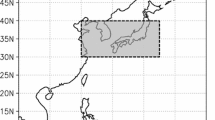Abstract
This study analyzed that there was a strong negative correlation between sea surface temperature (SST) in the equatorial Eastern Pacific and tropical cyclone (TC) frequency that affects Korea in summer season in 1951 to 2012. Then, 12 years that had the highest region-averaged SST values in the equatorial Eastern Pacific (warm SST years) and 12 years that had the lowest SST values (cold SST years) were selected, followed by analyzing average difference between two groups to identify any causes of possible correlation between SST in the equatorial Eastern Pacific and TC frequency. In the warm SST years, not only TC frequency that affected Korea but also TC genesis frequency was low, as well as TC intensity. A difference of 500 and 850 hPa streamlines between two groups showed that anomalous northwesterlies were strengthened in Korea due to anomalous cyclonic circulations developed in the mid-latitude region in East Asia, so that such anomalous steering flows played a role in preventing TCs from moving to Korea. Furthermore, anomalous anticyclonic circulations were strengthened in the east of Taiwan, which was related to weakening of the monsoon trough, thereby causing lowering TC genesis frequency in the warm SST years. In addition, as anomalous cyclonic circulations were strengthened in the southeast quadrant of the tropical and subtropical western North Pacific, it created high TC genesis frequency in the sea in the warm SST years. Low TC frequency, low TC genesis frequency, and low TC intensity that affected Korea in the warm SST years were clearly seen by the analysis of differences between two groups with respect to 500 and 850 hPa air temperature, 600 hPa relative humidity, precipitable water, 200–850 hPa vertical wind shear, and sea surface temperature.












Similar content being viewed by others
References
Alland JC, Komar PD (2002) Extreme storms on the Pacific Northwest Coast during the 1997-98 El Niño and 1998-99 La Niña. J Coast Res 18:175–193
Anthes RA (1982) Tropical cyclones: their evolution, structure, and effects. American Meteorological Society, Boston, 208 p
Chan JCL (2000) Tropical cyclone activity over the western North Pacific associated with El Niño and La Niña events. J Clim 13:2960–2972
Chen TC, Weng SP, Yamazaki N, Kiehne S (1998) Interannual variation in the tropical cyclone activity over the western North Pacific. Mon Weather Rev 126:1080–1090
Choi KS, Kim BJ (2007) Climatological characteristics of tropical cyclones making landfall over the Korean Peninsula. Asia Pac J Atmos Sci 43:97–109
Choi KS, Wu CC, Wang YQ (2011) Effect of ENSO on landfalling tropical cyclones over the Korean Peninsula. Asia Pac J Atmos Sci 47:391–397
Clark JD, Chu P (2002) Interannual variation of tropical cyclone activity over the central North Pacific. J Meteorol Soc Jpn 80:403–418
Gray WM (1984) Atlantic seasonal hurricane frequency. Part I: El Niño and 30 mb quasi-biennial oscillation influences. Mon Weather Rev 112:1649–1668
Hastings RA (1990) Southern oscillation influences on tropical cyclone activity in the Australian/south-west Pacific region. Int J Climatol 10:291–298
Kalnay E et al (1996) The NCEP/NCAR 40-year reanalysis project. Bull Am Meteorol Soc 77:437–471
Kim JH, Ho CH, Baik JJ (2002) Study on typhoon around Korean Peninsula during the period from 1951 to 2001. J Kor Meteo Soc 12:436–439
Kistler R et al (2001) The NCEP/NCAR 50-year reanalysis. Bull Am Meteorol Soc 82:247–267
Lander MA, Guard CP (2001) Western North Pacific, North Indian Ocean, and southern hemisphere tropical cyclones of 1997. Mon Weather Rev 129:3015–3036
Lee DK, Jang DE, Wee TK (1992) Typhoons approaching Korea, 1960-1989 Part I: statistics and synoptic overview. J Kor Meteo Soc 28:133–147
Park JK, Moon SE (1995) The climatological characteristics of typhoon visit to Korea. J Korean Meteorol Soc 31:139–147
Park JK, Kim BS, Jung WS, Kim EB, Lee DG (2006) Change in statistical characteristics of typhoon affecting the Korean Peninsula. Atmosphere 16:1–17
Reynolds RW, Rayner NA, Smith TM, Stokes DC, Wang W (2002) An improved in situ and satellite SST analysis for climate. J Clim 15:1609–1625
Saji NH, Goswami BN, Vinayachandran PN, Yamagata T (1999) A dipole mode in the tropical Indian Ocean. Nature 401:360–363
Takayabu YM, Iguchi T, Kachi M, Shibata A, Kanzawa H (1999) Abrupt termination of the 1997-98 El Niño in response to a Madden-Julian oscillation. Nature 402:279–282
Wang B, Chan JCL (2002) How strong ENSO affect tropical storm activity over the western North Pacific. J Clim 15:1643–1658
Wang W, McPhanden MJ (2001) Surface layer temperature balance in the equatorial Pacific during the 1997-98 El Niño and 1998-99 La Niña. J Clim 14:3393–3407
Webster PJ, Moore A, Loschnigg J, Lben R (1999) Coupled ocean–atmosphere dynamics in the Indian Ocean during 1997–1998. Nature 401:356–360
Wilks DS (1995) Statistical methods in the atmospheric sciences. Academic Press, San Diego, p 467
Yoo SA, Jung JS (2000) Investigation on typhoon affecting Korean Peninsula in 2000. J Kor Meteo Soc 10:302–304
Yu L, Riencecker M (2000) Indian Ocean warming of 1997-98. J Geophys Res 105:16923–16939
Author information
Authors and Affiliations
Corresponding author
Rights and permissions
About this article
Cite this article
Choi, KS., Cha, YM., Kang, SD. et al. Relationship between SST in the equatorial Eastern Pacific and TC frequency that affects Korea. Theor Appl Climatol 121, 243–252 (2015). https://doi.org/10.1007/s00704-014-1238-4
Received:
Accepted:
Published:
Issue Date:
DOI: https://doi.org/10.1007/s00704-014-1238-4




